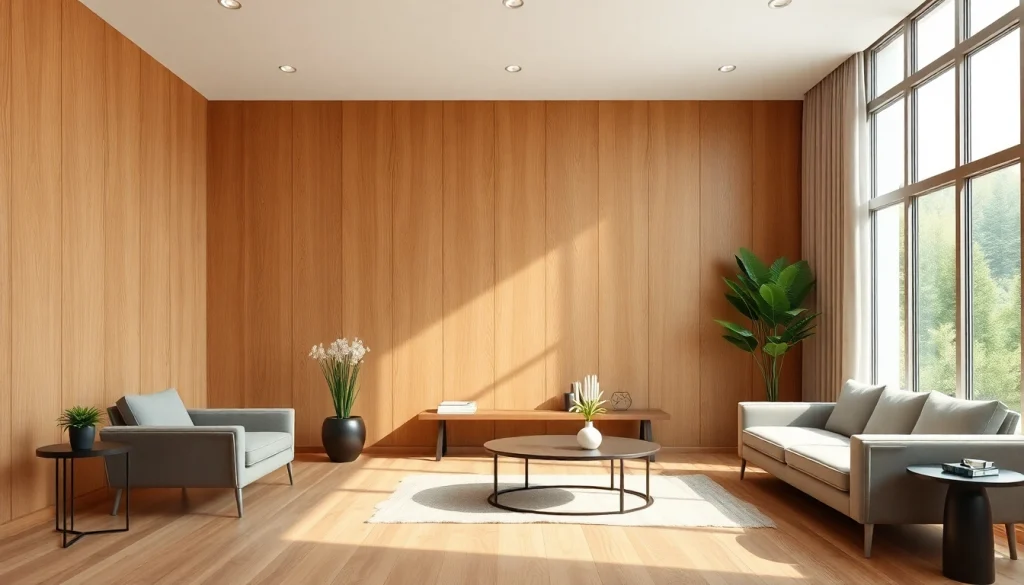Understanding Faux Wood Paneling
What is Faux Wood Paneling?
Faux wood paneling is a versatile material designed to replicate the appearance of natural wood, providing the aesthetic appeal of wood without the associated high costs and maintenance. Made from a variety of materials such as high-density fiberboard, PVC, or composite wood, faux wood paneling captures the unique grains, textures, and colors that characterize real wood. This makes it an attractive alternative for homeowners and interior designers looking to enhance the ambiance of their spaces with a touch of warmth and sophistication.
Benefits of Faux Wood Paneling
The adoption of faux wood paneling in interiors comes with numerous benefits:
- Cost-Effective: Faux wood paneling is generally more affordable than traditional wood, allowing for substantial savings without sacrificing style.
- Durability: Many faux wood panels are resistant to moisture and humidity, making them suitable for various environments including basements and bathrooms.
- Easy Installation: Compared to real wood, faux wood paneling is lightweight and often designed for easy DIY installation.
- Eco-Friendly Options: Some faux wood products are made from recycled materials, contributing to more sustainable building practices.
- Low Maintenance: Unlike real wood, which requires periodic sealing and refinishing, faux wood paneling can typically be cleaned with mild soap and water.
Common Uses in Interior Design
Interior designers commonly use faux wood paneling in various ways:
- Accent Walls: Creating a stunning focal point in a room, often contrasting against painted walls.
- Ceiling Treatments: Adding texture and visual interest to ceilings, which can enhance the overall height perception of a space.
- Room Dividers: Making open concept spaces feel more structured while maintaining an inviting atmosphere.
- Furniture Facades: Covering cabinets, bar areas, and more to maintain uniformity and design cohesion throughout a room.
Choosing the Right Faux Wood Paneling
Types of Faux Wood Paneling Materials
When selecting faux wood paneling, it’s crucial to understand the different materials available:
- High-Density Fiberboard (HDF): A popular choice for its affordability and ease of installation, HDF panels mimic the look of real wood and are suitable for low to moderate traffic areas.
- PVC Panels: These panels are moisture-resistant, making them ideal for kitchens and bathrooms. They’re lightweight, making them easy to handle and install.
- Composite Wood: Made from a mix of wood fibers and polymers, composite wood panels offer durability and can closely resemble natural wood finishes.
Color and Texture Options
The variety of colors and textures available in faux wood paneling enhances its adaptability:
- Natural Wood Shades: From deep mahogany to light oak, the spectrum of colors allows for easy matching with existing design elements.
- Textured Finishes: Embossed patterns can further emulate the feel of real wood surfaces, bringing depth to walls and ceilings.
- Paintable Options: Some faux wood panels can be painted, allowing for customization to match any decor style.
Factors to Consider for Your Space
Choosing the right faux wood paneling involves examining several factors:
- Room Use: Consider the function of the room where the paneling will be installed. High-traffic areas may require more durable materials.
- Lighting: The amount of natural light influences how colors and textures will appear. Darker shades may absorb light, while lighter colors can brighten a space.
- Design Theme: Ensure that the style of paneling complements your overall design theme, whether it’s modern, rustic, or traditional.
Installation Techniques for Faux Wood Paneling
Preparing Your Walls
Before installation, wall preparation is key to achieving a polished look:
- Clear the Walls: Remove any existing décor, nails, or fixtures on the wall surface.
- Repair Imperfections: Fill any holes or cracks and sand the surface for a smooth finish.
- Level the Surface: Ensure walls are level and, if necessary, use underlayment to create a uniform base.
DIY Installation vs. Professional Help
Deciding between DIY installation and hiring professionals depends on several factors:
- Skill Level: Assess your own DIY skills; if uncertain, professional installation might be the best choice for optimal results.
- Project Scale: Large projects, such as entire room paneling, may benefit from experienced installers for efficiency and finish quality.
- Time Consideration: DIY efforts might take longer, while professionals can often complete installations quickly and efficiently.
Tools and Materials Needed
For a successful faux wood paneling installation, ensure you have the right tools:
- Tools: A measuring tape, level, saw (circular or miter), hammer, adhesive (or nails), and safety gear.
- Materials: Panels, underlayment (if needed), adhesive or nails, and paint or finish (for customization).
Maintenance of Faux Wood Paneling
Cleaning and Care Tips
Maintaining the appearance and integrity of faux wood paneling is straightforward:
- Regular Dusting: Use a soft cloth or feather duster to remove surface dust to keep the panels looking fresh.
- Mild Cleaning Solutions: For deeper cleaning, gentle detergents in warm water are effective; avoid harsh chemicals that can damage the surface.
Long-term Durability Considerations
Faux wood paneling materials are generally designed for longevity, but some factors can impact durability:
- Moisture Exposure: Ensure that areas prone to moisture are adequately ventilated and use moisture-resistant products where possible.
- Sunlight Exposure: Direct sunlight can fade colors over time, so consider UV-blocking treatments on windows to protect your paneling.
Signs of Wear and How to Address Them
Awareness of potential wear signs can help in timely maintenance:
- Fading or Discoloration: If the panels lose their vibrancy, consider reapplication of paint or color-coating.
- Cracking or Peeling: Repair or replace damaged panels swiftly to maintain the integrity of the installation.
- Adhesive Issues: If panels begin to loosen, reapply adhesive or consider using additional fasteners for stability.
Styling Ideas with Faux Wood Paneling
Combining Faux Wood with Other Materials
Faux wood paneling pairs beautifully with various materials, enhancing aesthetic appeal:
- Metal Accents: Combining faux wood with metal fixtures can create an industrial-style ambiance that is both modern and inviting.
- Textiles: Incorporating fabric textures like curtains or cushions can soften the boldness of wood paneling.
- Glass Elements: Glass tables or decor juxtaposed with wood paneling can add contrast and depth to your design.
Accent Walls and Room Dividers
Faux wood paneling serves as a stunning feature for accent walls and room dividers:
- Bold Statements: Design a striking accent wall in your living room or bedroom with a contrasting color scheme to create visual interest.
- Functional Dividers: Use faux wood paneling to define spaces within open floor plans, ensuring a flow that still allows for distinction.
Creating a Cohesive Design Theme
Lastly, achieving design cohesion is vital for overall aesthetics:
- Color Matching: Ensure that the faux wood tones complement other elements in the room, from furniture to artwork.
- Consistent Styles: Stick to a unifying theme, whether that’s rustic, modern, or eclectic, to create harmony throughout the space.

